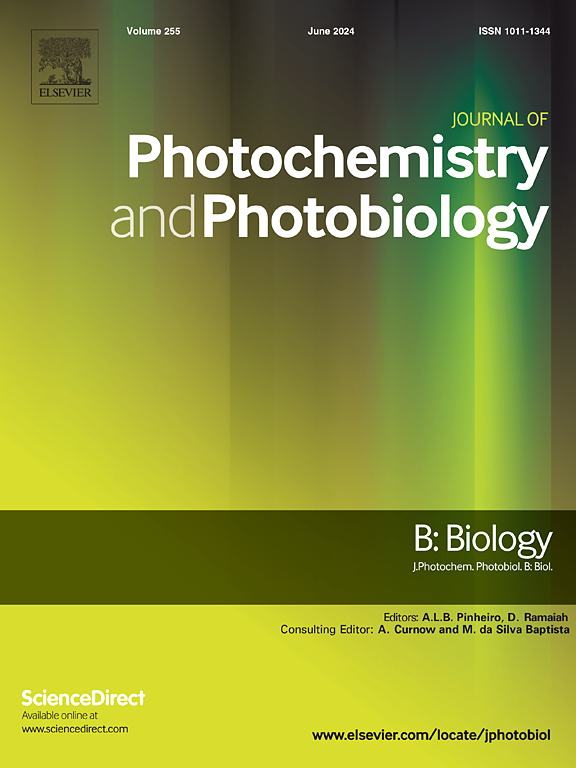ICG-ALA复合物用于改善癌症光疗
IF 3.9
2区 生物学
Q2 BIOCHEMISTRY & MOLECULAR BIOLOGY
Journal of photochemistry and photobiology. B, Biology
Pub Date : 2025-01-31
DOI:10.1016/j.jphotobiol.2025.113121
引用次数: 0
摘要
基于5-氨基乙酰丙酸(ALA)的光动力疗法(PDT)是一种临床认可的治疗癌症的治疗方法。另一方面,吲哚菁绿(ICG)是fda批准的一种荧光染料,已广泛用于近红外(NIR)医学成像,最近被认为是一种诱导光热疗法(PTT)的药物。然而,ALA的亲水性和ICG在水或生理介质中的快速降解以及它们的不稳定性限制了它们的临床应用。此外,PDT和PTT联合治疗是一种有希望的替代单一治疗方法。本文提出ALA与ICG的静电结合可以绕过这些障碍,并通过PDT和PTT同时联合提供更好的治疗效果。与游离ALA或ICG相比,ICG-ALA在SKBR3和MDA-MB-231细胞系中均表现出高达50 μg /mL-10 mM ALA的良好生物相容性。ICG-ALA与640/808 nm 5 min共照射在极低浓度下对两种癌细胞的光毒性显著增强,当ICG-ALA当量浓度为2.5 μg /mL-0.5 mM ALA时,两种癌细胞的生存能力几乎完全丧失。在细胞辐照过程中观察到的温度升高和氧化应激升高导致caspase 3/7的释放与PTT和PDT的发生非常吻合。此外,ICG- ala显示癌细胞在近红外(ICG)和可见光(PpIX)区域的可视化,允许成像引导光疗。本文章由计算机程序翻译,如有差异,请以英文原文为准。
ICG-ALA complex for improved phototherapy of cancer
5-Aminolevulinic acid (ALA) based photodynamic therapy (PDT) is a clinically approved therapeutic method for cancer treatment. Indocyanine green (ICG) is on the other hand an FDA-approved fluorescent dye that has been widely used in medical imaging in the near-infrared (NIR), and lately recognized as an agent to induce photothermal therapy (PTT). However, the hydrophilicity of ALA and rapid degradation of ICG in aqueous or physiological media as well as their instability limit their clinical application. Besides, the combination of PDT and PTT is a promising alternative to a single therapy approach. Herein, electrostatic binding of ALA to ICG is proposed to bypass such handicaps and provide enhanced therapeutic outcomes with simultaneous PDT and PTT combination. ICG-ALA exhibited excellent biocompatibility up to 50 μg ICG/mL-10 mM ALA in the dark in both SKBR3 and MDA-MB-231 cell lines with higher cell uptake compared to free ALA or ICG. ICG-ALA treatment coupled with 640/808 nm 5 min co-irradiation caused significantly stronger phototoxicity in both cancer cell lines at very low concentrations, reaching near complete loss of viability at 2.5 μg ICG /mL-0.5 mM ALA equivalent concentration of the ICG-ALA. The temperature increase observed during irradiation of the cells and the elevated oxidative stress resulting in the release of caspase 3/7 agrees well with the onset of PTT and PDT. In addition, ICG-ALA demonstrates visualization of cancer cells in both NIR (ICG) and visible (PpIX) regions allowing imaging-guided phototherapy.
求助全文
通过发布文献求助,成功后即可免费获取论文全文。
去求助
来源期刊
CiteScore
12.10
自引率
1.90%
发文量
161
审稿时长
37 days
期刊介绍:
The Journal of Photochemistry and Photobiology B: Biology provides a forum for the publication of papers relating to the various aspects of photobiology, as well as a means for communication in this multidisciplinary field.
The scope includes:
- Bioluminescence
- Chronobiology
- DNA repair
- Environmental photobiology
- Nanotechnology in photobiology
- Photocarcinogenesis
- Photochemistry of biomolecules
- Photodynamic therapy
- Photomedicine
- Photomorphogenesis
- Photomovement
- Photoreception
- Photosensitization
- Photosynthesis
- Phototechnology
- Spectroscopy of biological systems
- UV and visible radiation effects and vision.

 求助内容:
求助内容: 应助结果提醒方式:
应助结果提醒方式:


